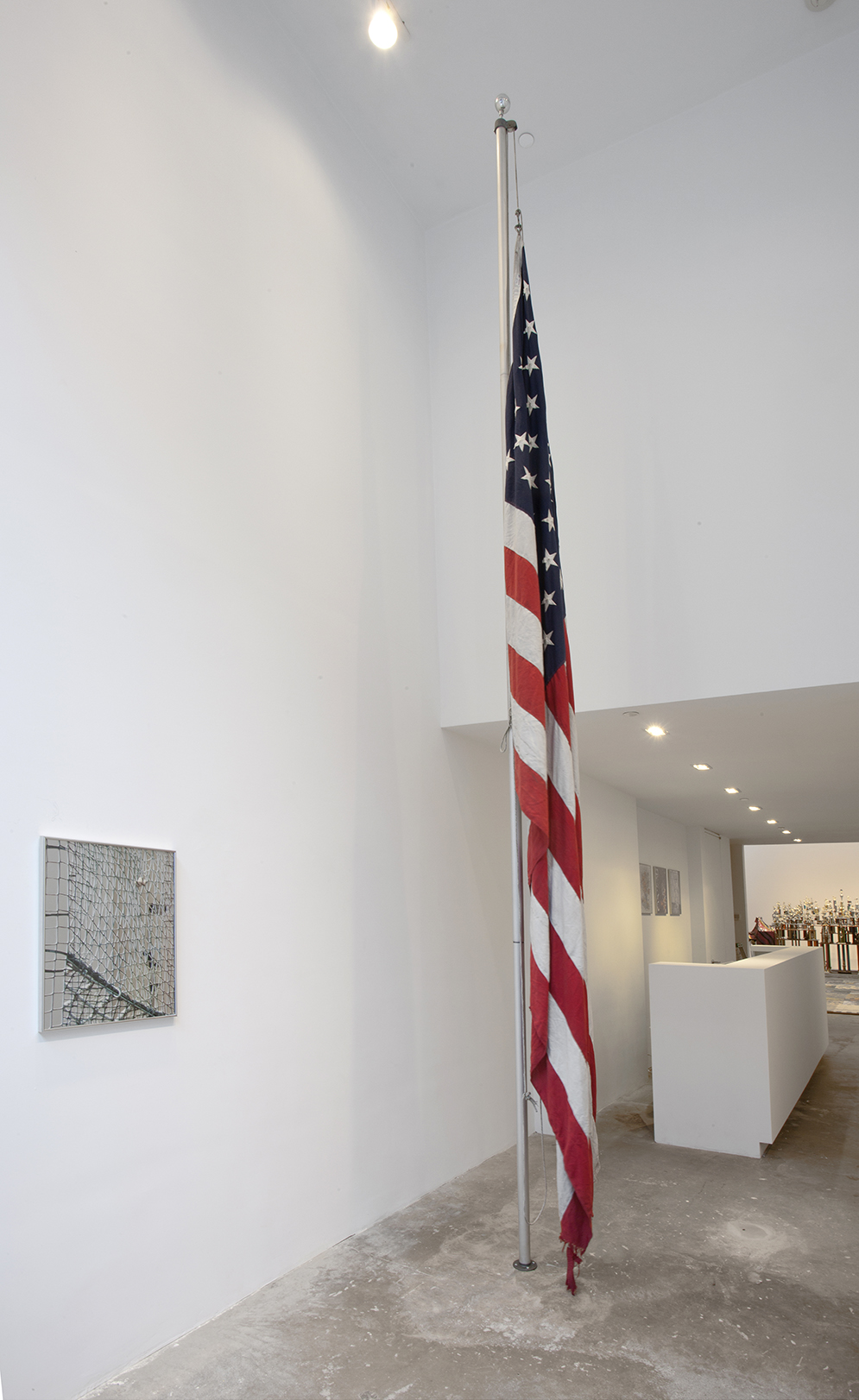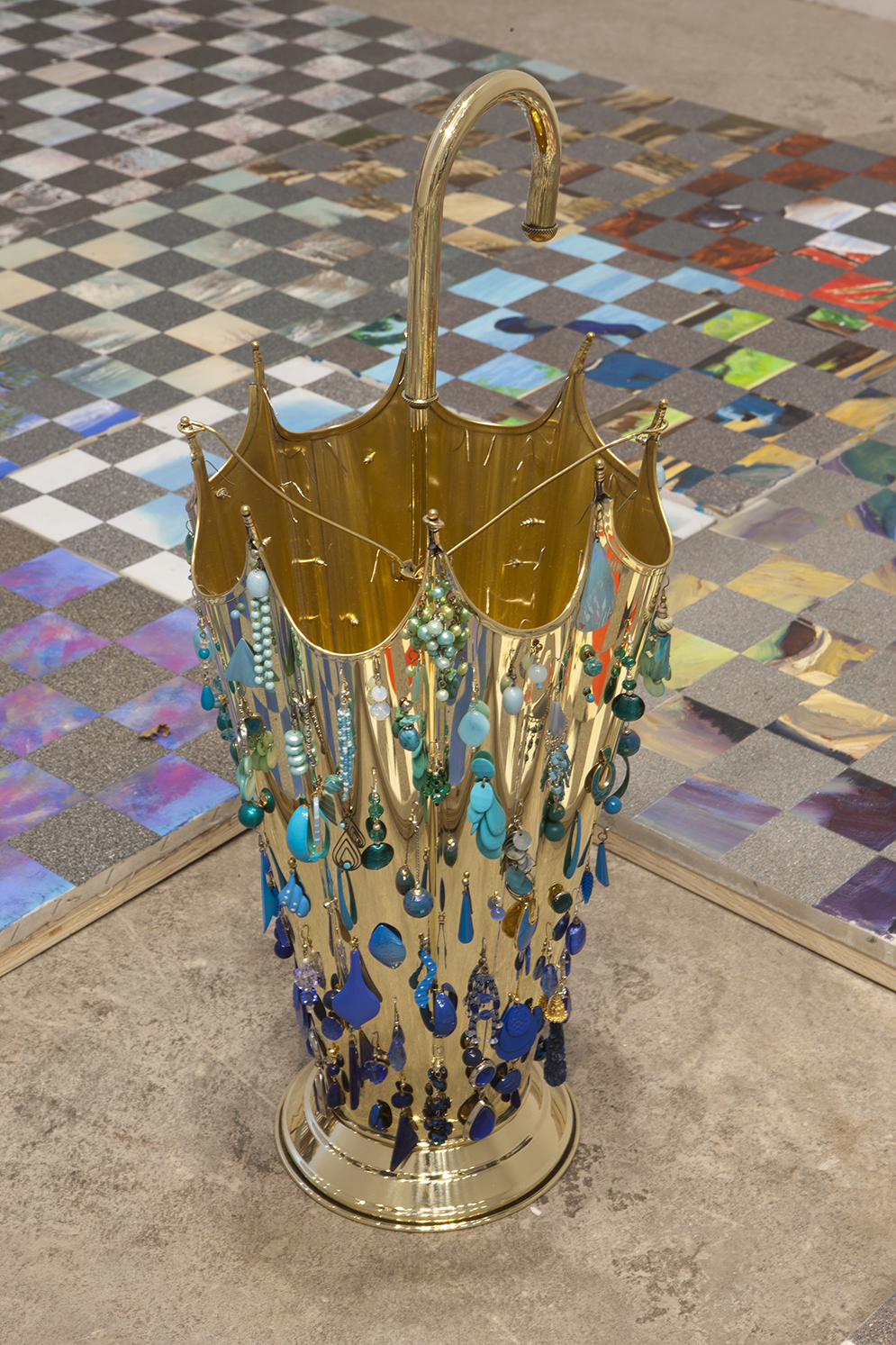Ry Rocklen has developed a language that is poetic and unique. His originality is an accomplishment considering the thousands of artists who used found objects in their work. Ry inserts old objects with his artistic mojo, giving them new life in a different realm. Perhaps you caught his previous outings in New York City at Marc Jancou in 2009 or in the Whitney Biennial of 2008. Rocklen’s latest New York show is up at Untitled on the Lower East Side until October 16th.
Brent Birnbaum: You could not escape the media letting us New Yorkers know this 9/11 was the 10-year anniversary of the World Trade Center attacks. Your current show opened on September 7th and one of the first works you see upon entering the gallery contains a large weathered American flag. A few threads gently touch and hover above the ground. In another sculpture titled Dreams of Liberta, a pillow with an American flag image is used. Was the 9/11 anniversary something you were conscious of when preparing for this show?
Ry Rocklen: In the wake of 9/11 the American flag bled into the fabric of our everyday lives, its colors and design found in a host of objects important to us as Americans and as people. Through pens, pillows, towels, bandannas, clothing, and flags we celebrate our great nation and remember the tremendous loss brought about on that day. I am excited by all these permutations and the liberties taken with the flags design in fitting whatever object it is adorning. With “A Touch of Grace” I was intrigued by the idea and form of a flag that hangs the length of the pole and comes as perilously close to the ground as possible.
BB: You are not surprised when you see a sculpture involving trophies anymore, yet they are rarely used successfully. Your giant trophy sculpture, Second to None, is the most
successful I’ve seen. How long did it take to collect all the trophies used?
RR: Trophies, not unlike American flags, have grown in abundance, as the fabrication of their parts has become a multi-million dollar a year industry. On a regular visit to Junk Shop 3D I saw 100 or so trophies sitting together on a high shelf. I was immediately attracted to their sparkle, form, and all that they have come to represent. I left them behind wondering how I would use them. On the car ride home I decided to find a way to bring all the golden statues on the tops of trophies to the same level, with the smallest of trophies rising high as the tallest. The next day I returned to buy the trophies and over the course of the next year and a half collected, planned, and assembled Second to None.
BB: We can guess you might have trolled eBay and local thrift stores, but did you have any unexpected encounters on this trophy hunt via Craigslist or some other source? I’m picturing some middle-aged ex-motocross dude who is finally parting with his old trophies he has kept displayed in his garage. Maybe this is part of the power of the work – thinking of accomplished childhood dreams turned into passé objects occupying valuable space. What do you think about this?
RR: I look at the collection of trophies as the crystalline materialization of practice, passion, and dedication. A trophy is both a bi-product and a means to an end. They are the treasure at the end of a voyage and a symbol of the love for the journey. Once I bought the bulk of trophies from Junk Shop 3D it became easier to procure them. The collection had its own gravity and soon without me trying friends and family were giving me their old trophies.
BB: Furthermore, did you play sports growing up and receive any trophies in your childhood? I’m wondering if nostalgia is involved personally for you in the creation of this work. The final work seems like a clean slate. The personalization is gone and now we are all after the one “big fish.” It also made me think of collectors “trophy hunting” through the galleries.
RR: When I was a kid I really wanted to win trophies and although I didn’t play many sports. When I saw all the trophies on the shelf at Junk Shop 3D the same part of my psyche that was attracted to trophies as a child was activated as an adult. I consider the sculpture a celebration of the trophies themselves, their design, their form, and the logic and language of the world of trophies. The sculpture becomes an armature onto which we can project countless stories of triumph and accomplishment.
BB: Let’s stay with Second to None and dissect your process once more. Did you go through several ideas of how to use the trophies before settling on the winner? If so, can you share to unrealized ideas?
RR: The basic idea for Second to None was a constant, to bring all of the tops of the trophies to the same level. I realized early on I did not want Second to None to include anything outside the material and formal language of the trophies. That meant no plexi-glass, no fishing line, no glue, etc. Instead I used existing means of trophy production, ordering parts from trophy suppliers, to assemble Second to None.
BB: Let’s discuss The Queen’s Reign. What came first – knowing how you wanted to use the earrings or finding the umbrella stand?
RR: On my way home from the studio I spotted the umbrella stand used in The Queens Reign being sold as part of a sidewalk sale, so I pulled over and bought it. Once I got the umbrella stand back to the studio I envisioned it covered with earrings shaped like water drops. I liked to strangeness of the combination of objects and the simplicity of its making, collecting earrings, drilling holes in the umbrella stand and hanging the earrings through the holes.




 RSS
RSS
